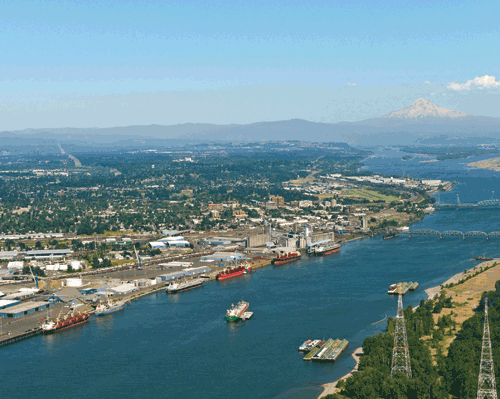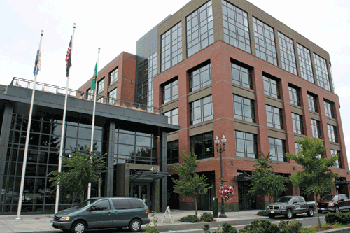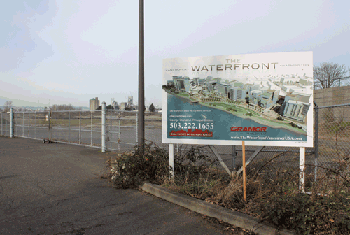Editor’s Note: This is the most recent installment of a recurring feature examining how individual communities & jurisdictions in Clark County are poised to adopt and take advantage of the recently adopted county-wide Economic Development Plan.
Build it and they will come. That is the optimistic outlook of several people in Vancouver tasked with driving economic development in and around Vancouver.
Case in point: the Port of Vancouver’s West Vancouver Freight Access Project. Curtis Shuck, director of economic development and facilities at the Port, said this $150 million project is leveraging a two-to-one ratio of private investment. He cited United Grain’s $90 million investment in a new facility on port property, as well as BHP Billiton, which is investing $300 million in a potash export terminal at the port.
“A huge part of Vancouver’s future is bound up with the port’s infrastructure,” said Lisa Nisenfeld, president of the Columbia River Economic Development Council (CREDC).
The Economic Development Plan released by the CREDC last summer specifically calls for investment in “the infrastructure and amenities needed to attract new businesses and talent.” In pursuit of this goal, according to Shuck, the Freight Access project is two years ahead of schedule, thanks to recent federal grants

100 people are working to finalize the design, Shuck explained, and the Port has applied for $80.5 million from the federal Rail Rehabilitation and Infrastructure Financing (RRIF) program. At build-out, he said, the average daily rail car traffic at the port will increase from about 100 cars to 700 or 800 cars.
Not far away, the Waterfront Park project is also on a fast track. Alisa Pyszka, business development manager for the city of Vancouver, said a half-million dollar grant from the state, combined with $250,000 from the city’s Park Impact Fee program, has enabled the city to hire PWL Architects (based in Vancouver, BC) and local planning and engineering firm BergerABAM to finalize the park’s design and obtain all necessary permits.

Another important piece of the economic development of Vancouver is the Vancouver City Center Vision (VCCV), which, according to the city’s website, aims to create and support a dynamic and rich mix of residential, civic, retail and entertainment places that will attract growth, jobs and round-the-clock activity downtown.
“The city center development will be a huge resource for all of us,” said Nisenfeld. “Businesses that locate here will benefit from the professional services” such as attorneys, banking, and accountants.
Pyszka said the city has already implemented some of the recommendations in the VCCV, such as consolidating city offices and re-evaluating the parking program to make it more flexible. The next step, said Pyszka, is to “heighten awareness of the opportunities downtown,” such as future light rail services and connections to neighborhoods to the north.
Pyszka also mentioned that the city is working on smaller, pilot infrastructure projects in areas of activity, such as on 9th Street, which is home to recent arrivals such as Mt. Tabor Brewing, architectural engineering firm MGH Associates, and an antique shop. She said the city is applying for a grant to fund improvements in this area, such as consolidating dumpsters into a trash compactor, providing electric vehicle and bicycle parking, planting trees, and putting in landscaping that supports stormwater management.
Elsewhere in downtown, said Pyska, there is evidence of a “small business, knowledge-based, entrepreneurial economy starting to sprout.” For example, web development firm Gravitate Design Studio, located on the second floor of the Koplan Building on Washington Street, is considering making some of their office space available to incubate other small businesses. Sigma Design, an engineering consulting firm, she said, has converted an “old mechanic shop into a fabulous office space” on 19th and Broadway.

Nisenfeld said that single-ownership parcels of land like the port’s are few and far between in the county. Multiple owners can slow the process of bringing a piece of property to market, which Shuck said can be a death knell to attracting businesses to the area.
“You can market until the cows come home,” said Shuck, “but if there’s no place to land, it won’t do much good.”
Shuck said that it was important to have truly shovel-ready parcels of 20 acres or more, with all entitlements, development agreements, and permits in place.
“The market moves quickly,” he said. “If you’re not ready to move when they are, they will pass you by like a cheap suit.”
Both Nisenfeld and Shuck agreed that a possible solution to having enough land ready for companies interested in locating in Clark County would be land banking, where all three of the region’s ports work together to purchase and hold land for future projects.
Making a collaborative effort, such as land banking, is one of the best results of the Economic Development Plan, according
to Shuck.
“It’s a nexus to bring people together and build a sense of urgency,” he said.
Shuck also noted that “watching the transformation of the economic development players” – both public and private sector entities – is encouraging.
“A lot of people are working hard on this,” he said. “It’s exciting to see them rolling up their sleeves, and taking a more collaborative approach.”



